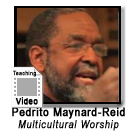|
|
|
|

Worship and music have been intimately connected since biblical times. Yet music in worship has become a point of contention - a great chasm separating the young and the not-so-young, the conservative and the liberal, and, quite possibly, the members of the church you attend. Is there a solution to this ongoing battle? Lilianne Doukhan takes on this sensitive issue with a remarkable combination of finesse and refreshing candor. | |
|
|
 Editorial Editorial 
|  | | |  In past centuries it was not uncommon for wealthy families to have their own reserved pews in church. This is certainly not the current practice in our congregations (I hope!). But have you noticed that most worshipers still sit in the same place every week? And we have all at least heard horror stories of a dear "saint" telling guests to move because they are in "his" or "her" seat. Such inhospitable requests are obviously unfortunate, but the desire for predictability is actually quite understandable. We live in a culture obsessed with novelty. And worship is not immune from this reality. It has shaped my own longstanding image of the ideal worship planning meeting: a prayerful gathering of creative, God-fearing people sitting around a blank sheet of paper and asking, "what will we do this week?" I am slowly realizing, however, that a totally blank sheet of paper (dry erase board, computer screen, etc.) may not always be the best starting point. The notion of completely re-inventing worship every week has little to do with historical Christian practice and more to do - I fear - with potentially misleading analogies between worship and current entertainment rituals. Unlike an audience at a concert or play, worshipers are not primarily spectators; they are invited to be active participants. Novelty may make for appealing entertainment, but it's often not conducive to participation. Unfamiliar worship patterns might be interesting to watch, but they are difficult to do. Preparing to come before our Creator should of course inspire creativity. But neither profound creativity nor participation can flourish in a mercurial environment of constant change. Participatory worship - like participatory singing - requires a certain rhythmic regularity. Even innovations - syncopations, if you will - are only intelligible within a constancy of pulse and meter. Meaningful, participatory corporate worship is not easy to plan. It requires prayer, pastoral sensitivity, and an array of liturgical and artistic gifts. If we are able to discern an underlying pattern that adequately embodies our identity and what we believe, we would likely do well to cultivate it over time. This may provide the best opportunity for God to cultivate us over time as we participate holistically in worship. It is certainly not necessary to sit in the same pew every week, but neither do we want to make people play - literally or metaphorically - a game of musical chairs. I have named a challenge that is impossible to adequately address in this brief discussion. But here are a few admittedly leading questions: How can we creatively innovate in worship without leaving the worshipers behind - how can we be creatively inspiring within patterns that enable participation? Does our worship teach our congregations to expect a presentation or an opportunity to be present to God? Is regularly re-thinking a service's essential order and architecturethe best use of our worship team's creative energy and time? How can our worship reflect a God who is both unpredictable and unchanging? Does our worship offer participants a spectacle to watch or spectacles through which they can see God's revelation and presence in new ways?
 Discuss this article on Facebook Discuss this article on Facebook
| |
 Reflecting on Scripture Reflecting on Scripture 
|  | | | 
The Institutionalization of God
by Dave Gemmell
Fresh pine scented air rushed through the open door of the tour bus welcoming me to the top of Mt. Tabor, the traditional site of the transfiguration.My feet steadied as I stepped out into the dazzling blue sky after getting rocked in the bus climb up the 2,000 foot mountain.I wasn't sure what to expect as I stood on perhaps on the same spot where Peter, James and John knelt before Elijah, Moses and Jesus blooming with the dazzling light of heaven.
With management expectations in full gear I was able to dial down enough to witness the ironic fulfillment of Peter's exclamation: "Let us put up three shelters-one for you, one for Moses and one for Elijah."Actually standing on Mt. Tabor I only saw two shelters: the Catholic Church of the Transfiguration and the Eastern Orthodox temple; all that remained of centuries of church construction, war, demolition, rebuilding; each an attempt to fulfill Peter's misguided wish to institutionalize God.
Who could blame Peter for wanting his mountaintop worship moment to last forever? We've all had our own theophanys where God appeared in our lives. We want that moment to last forever - that powerful church worship service--the spirit filled revival--the ecstatic retreat - or that private time when we sensed God's presence. So we try in vain to institutionalize God's presence through buildings, liturgy, spiritual phrases, song selection and musical styles. While those things may serve to help trigger spiritual memories, they will not recreate the theophany.
So What can we learn from Peter?
1) All attempts at preserving or duplicating theophanys fail. Those mountaintop experiences are one-time events never to be identically repeated. Any expectation that we can recreate a God moment can actually serve as a stumbling block preventing fresh theophanys. We become stuck in the (fill in your own decade). As our life experience changes so does our need for fresh worship experiences.
2) Theophany raises vision. Peter had stalled out in his mission and needed the glimpse of heaven to raise his vision beyond that of a minuscule worldly political kingdom. When our vision needs expansion God shows up.

3) Theophany drives mission. Yet, now that he had the theophany Peter could not remain indefinitely on the mountaintop. The vision necessitated that he walk back down the mountain and let the bright lights of heaven drive him back into expanded ministry. We mustn't loiter around the church too long. Our mission is elsewhere.
As worship leaders we need to make new space for God every week. That doesn't mean that the liturgy needs to be perpetually scrambled but it does mean that each worship service must be prayerfully designed for a fresh opportunity for God to appear.
 Discuss this article on Facebook Discuss this article on Facebook
| |
 Leadership Leadership 
|  | | |
 Growth Points: Simple Strategies to Stretch Your Worship Teams Growth Points: Simple Strategies to Stretch Your Worship TeamsBy Bobby G
Worship leaders are busy people. We're constantly multitasking. But even in our busyness, we can use simple strategies to facilitate the personal growth of our teams.
The Gospels record a story that shows that Jesus values personal growth. It's the story of the Rich Young Ruler. At the close of the story, Jesus challenges the ruler to go, sell all he has and give it to the poor. In other words, Jesus gives him a growth step.
But you don't have to be Jesus asking to sell everything. There are several fitting ways we can ask those we lead to step up as musicians, vocalists and Christians. Could any of your teams benefit from meeting these challenges?
The Audio Team · Attend mid-week or monthly rehearsals and planning meetings · Network with other churches so team members can observe how other sound engineers handle frequent challenges like feedback and "more-of-me" mixing
The Graphics/Video Team
· Attend mid-week or monthly rehearsals and planning meetings · Use websites like SermonSpice.com and WorshipHouseMedia.com to create visuals based on a shared understanding of the direction or theme of the message or service
The Vocalists
· Memorize lyrics and arrangements · Arrange keys for the congregation and adapt vocal parts accordingly.
The Band Members
· Memorize songs and arrangements. · "Less-of-me" musicianship: play in a way that esteems your bandmates "greater than yourself."
The Leader(s)
· Communicate set lists early enough so that team members can (be expected to) come prepared to rehearsal. · Utilize transitions and vocal arrangements to share and develop leadership · Establish a tri-annual audition process to facilitate team growth steps
The Pastor
· Include worship leaders in the sermon calendar and message preparation process · Invest in a website like PlanningCenterOnline.com to facilitate healthier team communication · Participate in a church health process such as Natural Church Development (NCD) to determine areas of church and leadership growth
All Teams
· Attend a regional or national church leadership conference or · Schedule an in-service or coaching session(s).
One final thought on growth steps. By providing growth points throughout one's ministry service, you have structured ministry to mirror the Christian life. Our journey with Jesus isn't simply a decision to follow and that's it. It's a daily surrender, two-steps-forward, one-step-back type of journey. Providing growth steps for your worship teams helps to reinforce this reality and encourage improvement in all areas of our lives.
How do you facilitate personal and team growth? If you have a creative way you're implementing growth opportunities for your teams, we'd love to hear them. Let us know by posting on Facebook.  Discuss this article on Facebook Discuss this article on Facebook
www.bobbyg.org
| |
 Worship Leading Worship Leading 
|  | | |
There has always been a lot of debate about which of the two is better - being spontaneous or calculated in worship leading. However, I don't see how you can truly be effective without a little bit of both!
Once the theme has been established (from our liturgical calendar), and the worship planning committee has placed songs and other worship elements in place, I begin planning the worship experience; I do it with my guitar or at a piano. I play through the parts of the songs and transitions to feel the journey that this worship experience is going to take me, my team and my congregation on. I feel the ebbs and flows that come from the peaks and valleys of the music. It allows me to feel where silence may be needed, where prayer may be needed or where a few words of testimony might further drive home the point. All these elements are essential to creating an effective worship experience for your congregation but too often overlooked or over-planned, creating a distraction to worship rather than a bridge from one important element to the next.
To create experiences that lead people to Jesus in an authentic manner, you must be both spontaneous and calculated. You must go through the worship experience yourself and feel the ups and downs, the praises and yearnings. You must be inspired by the Holy Spirit and the songs themselves and allow them to reach people fully. By experiencing the worship on your own, you will know how you can effectively lead it. By being present in the worship experience you will be in tune with the prompting of the Holy Spirit, the needs of the congregation and the abilities of the worship team. www.rickandersonworship.com
| |
 Worship Planning Worship Planning 
|  | | |

Worship Planning for the Church Year
Walk into any worship service any given Sabbath and you're likely to experience worship focused on some particular theme. In my role as Minister of Music and Worship, I spend countless hours with my pastor and worship team planning our weekly worship services and those with special emphases (i.e. Women's Day, Youth Day, Communion, Community Service Day, etc.). In addition to the liturgical themes that are celebrated across a variety of ecclesial traditions - Easter and Christmas, for example; there are also cultural themes that influence our worship planning, such as Earth Day or World AIDS Day. To assist in the preparation of worship services, some denominations follow a strict lectionary. A lectionary is described as "a book or listing that contains a collection of scripture readings appointed for Christian or Judaic worship on a given day or occasion. Lectionaries follow set themes following the festivals and special days of the Christian year. Since 2007, I have served as a Liturgist, writing music and worship materials for one such resource - The African American Lectionary (TAAL) (www.theafricanamericanlectionary.org), the first ecumenical worship resource that is multi-dimensional in both its approach and its design. There are biblical readings for over 60 liturgical moments and TAAL provides commentaries forsermon primers, cultural and historical resource information, and music/arts resources to facilitate worship planning. In addition to the days most are familiar with, I have written for some special services including: Ecumenical Day, Anti-Incarceration Day (Prison Ministry), World AIDS Day, Election Day, Disability Awareness, Anti-Domestic Violence, Service of Healing, and others. TAAL has been blessed to include commentaries written by SDA pastors, as well as music references of many of our artists, singers and writers. While this particular resource is primarily geared to African American congregations, in the 3 years since its inception, many non-African American pastors and worship leaders have referenced TAAL for the vast richness of its worship material and depth of creativity that can readily be applied across many congregations. I encourage you to go online and review the material! In Seventh-day Adventism, we do not utilize a denominational lectionary; nevertheless, in addition to The African American Lectionary, there are many denominational resources available to our pastors and worship planners that provide a wide array of materials and resources that can fit your congregation's worship traditions and needs. Some examples are: · Adventist Women's Ministries (www.adventistwomensministries.org), which has worship planning resources for special emphasis days such as: International Women's Day of Prayer, Women's Ministries Day, and Abuse Prevention Emphasis Day. · Children's Ministries (www.childmin.com), which has resources for Children's Sabbath, Vacation Bible, School, etc. · Adventist Community Services (www.communityservices.org), which has sermon and video resources for planning Community Service Sabbath. · Adventist Singles Ministries (www.adventistsingleadultministries.org), providing worship resources for Adventist Single Adult Ministries Sabbath. In lieu of focusing an entire service on a particular theme, you may choose to utilize a single element of the service for the special emphasis such as your congregational reading, prayer, and of course music (hymns, praise and worship, musical responses, etc.). At Capitol Hill SDA, our Pastor, Dr. Gene Donaldson introduced a segment called, "Can We Talk?" which enables the leader to give 3-4 minutes of focused attention to a specific interest. Whatever your approach, I encourage you to review and to take advantage of the many resources available to you, both within and outside of our denomination, to support your worship planning. As always with all worship planning and leadership, the critical first step is communion with God. As worship planner for our congregation, my guiding principle is taken from Matthew 6:10 (NCV) - "May Your kingdom come, and what you want [WORSHIP] be done here on earth, as it is in heaven." (emphasis added) | |
 Featured Media Featured Media 
|  | | |
Music and Worship Conference Videos Online
Two presentations from the 2011 Andrews University Music and Worship Conference, a Vervent Adventist Worship Conference, are now online.

"Diversity in Worship" was presented by Dr. Roberta King at the Andrews University Music and Worship conference, March 24-26, 2011.
Roberta King is associate professor of communication and ethnomusicology in the School of Intercultural Studies at Fuller Theological Seminary. Since coming to Fuller in 2000, she has served as All-Seminary chapel director and developed a new curriculum for "Ethnomusicology in Mission" renamed Global Christian Worship--at the MA level, and has recently launched a new Doctor of Missiology in Ethnomusicology.

"Multicultural Worship: Melting Pot of Fruit Salad?" was presented by Pedrito Maynard-Reid at the Andrews University Music and Worship conference, March 24-26, 2011.
Pedrito Maynard-Reid is Assistant to the President of Walla Walla University for Diversity. he was the Vice President for Spiritual Life and Mission at Walla Walla College for 10 years prior to this appointment. He has also been Professor of Biblical Studies and Missiology in the School of Theology since 1990. Dr. Maynard-Reid is also an accomplished musician with degrees in piano performance from Schools of Music in the United Kingdom.
| |
 Worship Resources Worship Resources 
|  | | |
Director's Notes Theme: This short reader's theater drama brings the cost of the crucifixion up front and personal. The skit fits nicely for Easter or for a communion service. Reader's Theater: This script is designed for a reader's theater style of drama. In this style all of the readers face the audience and they look straight ahead. It is okay if the readers have their scripts in hand, but they should be very familiar, having rehearsed it several times. The pace is quite fast through most of the script with each line delivered just as the previous line is finished. Characters: The Nail calls for four characters. They are age and gender neutral. The only requirement is that the reader is articulate and can unpack the emotional energy of the piece. Tactile Handouts: To enhance the audience experience hand out a spike to each attendee as they come into the room. The experience of holding a real nail in their hands will add a tactile dimension. They can take the nail home with them to remember the experience. Graphics: In some performances slides have been placed on the screen of the crucifixion or of hammers and nails. Bible Graphics Studio (Pastor's DVD volume 8) has some extraordinary realistic crucifixion slides. | |
 To the Point To the Point 
|  | | |
"Liturgy's goal isn't meaning but meeting. And meetings are always risky. Christian worship is not doctrine disguised in ritual shorthand but action that draws us into the dynamic, hospitable, yet perilous space of God's own life."
Nathan D. Mitchell
"[T]he meeting between God and people in liturgy may - and probably should - provoke discomfort. Rituals behave - as Jesus did in his ministry - parabolically, and hence worship is not a self-congratulatory exercise where we showcase 'all the great stuff we're doing.' The point of our coming together in prayer is not congratulation and comfort but challenge and change."
Nathan D. Mitchell
"True worship consists in working together with Christ. Prayers, exhortation, and talk are cheap fruits, which are frequently tied on; but fruits that are manifested in good works, in caring for the needy, the fatherless, and widows, are genuine fruits, and grow naturally upon a good tree."
Ellen G. White, Christian Service, 96
| |
 Publishing Information Publishing Information |  | | | Best Practices for Adventist Worship is a Vervent publication of the NAD Church Resource Center. Editor: Nicholas Zork (email). You may republish pieces from Best Practices in your own newsletter or blog, with attribution to the Best Practices for Adventist Worship newsletter and the author. Permission should also be secured from the author.
We welcome your feedback and ideas.
| |
|
|
|
|
|
|